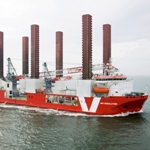New DNV Class Notation
 In response to the emerging offshore wind power market, DNV is launching the world’s first class notation for offshore wind turbine installation units. The new class notation, which will serve as a recipe for how to class wind turbine installation vessels, is currently being piloted and is expected to be added to DNV OSS-101 by October of this year.
In response to the emerging offshore wind power market, DNV is launching the world’s first class notation for offshore wind turbine installation units. The new class notation, which will serve as a recipe for how to class wind turbine installation vessels, is currently being piloted and is expected to be added to DNV OSS-101 by October of this year.
The new rules for wind turbine installation units focus on four main areas:
- General design and construction requirements for wind turbine, wave power and tidal power installation units.
- Design requirements for the different types of wind turbine installation units, which include ship-shaped units, self-elevating units and column-stabilised units.
- Structural details relating to the lifting operations and the many cycles of repeated vessel operations.
- Certification of materials and components.
The market for wind turbine installation units is growing rapidly as the offshore wind industry picks up pace. Now, the DNV-classification of these units is based on DNV’s Offshore Service Specification DNV OSS-101 ‘Rules for Classification of Offshore Drilling and Support Units’, which was originally developed for classifying drilling and production vessels used in the oil and gas industry.
“DNV has been involved in the wind turbine installation unit market since 2003, when it classed the Mayflower installation vessel. Today, we are in the forefront with new projects in all the major home markets for offshore wind farms, and we expect a significant increase in the coming years as we see several new projects are in different stages of development”, says Henning Carlsen, the business development manager in DNV’s Offshore Classification unit, “Compared to traditional oil and gas units, these vessels have a different set of safety and technical issues and are not normally designed for the hazards of the oil and gas industry, i.e. exposure to extreme weather and hydrocarbons leading to a risk of fire and explosions. This, in addition to increased requests from the industry, has motivated us to launch the new class notation.”






